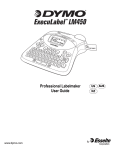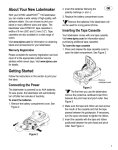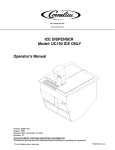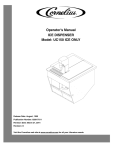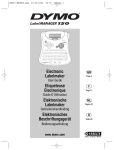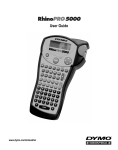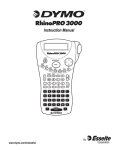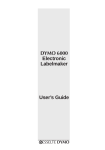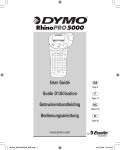Download Dymo ExecuLabel LP150 User guide
Transcript
TM Professional Labelmaker User Guide w US NZ AUS Label Exit Cutter LCD Display Align/Underline Box Power Style Print Ok Fixed Length/Font Memory/Extra Cancel Navigation Numeric Keys Clear/Delete Return Alpha Keys Language Symbols CAPS Space Bar Currency Shift Figure 1 ExecuLabel LP150 Professional Labelmaker 2 About Your New Labelmaker With your DYMO ExecuLabel™ LP150 labelmaker, you can create a wide variety of high-quality, selfadhesive labels. You can choose to print your labels in many different sizes and styles. The labelmaker uses DYMO D1 label cassettes in widths of 3/8” (9 mm ) and 1/2” (12 mm). Label cassettes are also available in a wide range of colors. Visit www.dymo.com for information on obtaining labels and accessories for your labelmaker. Warranty Registration Please complete the warranty registration card and return it to the appropriate Customer Support address within seven days. Visit www.dymo.com/ registration for details or to register online. 2. Insert the batteries following the polarity markings (+ and –). US AUS NZ 3. Replace the battery compartment cover. Remove the batteries if the labelmaker will not be used for a long period of time. Inserting the Label Cassette Your labelmaker comes with one label cassette. Visit www.dymo.com for information about purchasing additional label cassettes. To insert the label cassette 1. Lift the label cassette cover to open the label compartment. See Figure 3. Getting Started Follow the instructions in this section to print your first label. Connecting the Power The labelmaker is powered by six AAA alkaline batteries. To save power, the labelmaker will automatically turn off after two minutes of inactivity. To insert the batteries 1. Remove the battery compartment cover. See Figure 2. Remove cardboard insert Figure 3 The first time you use the labelmaker, remove the protective cardboard insert from between the print head and pinch roller. See Figure 3. 2. Make sure the label and ribbon are taut across the mouth of the cassette and that the label passes between the guideposts. If necessary, turn the spool clockwise to tighten the ribbon. 3. Insert the cassette with the label and ribbon positioned between the print head and pinch roller. See Figure 4. Figure 2 3 CLICK! Getting to Know the Labelmaker Become familiar with the location of the feature and function keys on your labelmaker. Refer to Figure 1 on the inside front cover. The following sections describe each feature in detail. Power Figure 4 4. Press firmly until cassette clicks into place. 5. Close the label cassette cover and press A to turn on the power. Selecting a Language You can select from a number of different language options. By default, the language is set to English. The language option you choose determines the default units of measure (inches or millimeters) and the character set that is available. To select a language 1. Press Language . 2. Use the arrow keys to select the language you want and press . Printing Your First Label You are now ready to print your first label. To print a label 1. Enter text to create a simple label. 2. Press . 3. Use the cutter lever to cut the label. Congratulations! You have printed your first label. Continue reading to learn more about the options available for creating labels. The A button turns the power on and off. After two minutes of no activity, the power is switched off automatically. The last label created is remembered and displayed when the power is turned back on. The previously selected style settings are also restored. You can also use the A button to cancel printing and return to edit mode. LCD Display The labelmaker’s LCD display shows a row of 13 characters. However, you can enter up to 99 characters and spaces. The display window can accommodate 13 characters. As you type more characters, they begin to scroll to the left. See Figure 5. The number of characters actually displayed can vary due to proportional spacing. The quick brown fox jum jumps over the lazy dog. Figure 5 In addition, feature indicators appear on the display to let you know when a feature is selected. See Figure 6. Font Style Fixed length # of copies CAPS mode Figure 6 4 Box/ Align/ Scroll Underline Justify bar CAPS Mode Cancel The # key toggles capitalization on and off. When CAPS mode is turned on, the CAPS mode indicator is shown on the display and all letters that you enter will be capitalized. The default setting is CAPS mode on. When CAPS mode is off, all letters entered appear in lower case. The key allows you to exit from a menu without making a selection or to cancel an action. Shift Key Extra Key The key, when used in combination with an alphabet key, changes the case of the selected letter. When used in combination with number keys or function keys, the key selects the alternate function shown on the key. For example, when you press , the character to the left of the cursor is deleted; however, when you press + together, the entire label text and formatting is deleted and the display is ready for you to type a new label. The key displays Units, Copies, Preview, and Print Contrast submenus. These features are described later in this User Guide. Space Bar The V key inserts one or more blank spaces in your text. Clear/Delete The key removes the character to the left of the cursor. Pressing + clears all label text and formatting. Navigation Keys You can review and edit your label using the left and right arrows on the navigation key. Using with the left or right arrows moves the cursor to the beginning or end of the label text. You can navigate through menu selections using the up and down arrow keys, and then press to make a selection. Return Key The key inserts a new line on your label. Formatting Your Label You can choose from a number of formatting options to enhance the appearance of your labels. The labelmaker remembers the last selection made so that each time you enter one of the feature menus described in this section, you are positioned at the last item selected from that menu. Changing the Font Three fonts are available for your labels: Arial Narrow, Arial Normal, and Arial Wide. When you select a font, that font applies to all characters on a label. To set the font 1. Press the key. 2. Use the arrow keys to move to the desired font and then press . 5 Adding Font Styles You can choose from six different font styles in addition to Normal: Normal Bold Italic Outline Shadow Vertical Mirror Figure 7 When you select a style, that style applies to all characters. Styles can be used with alphanumeric characters and symbols. See Using Symbols and Special Characters on page 6 for more information on printing symbols. To set the font style 1. Press the key. 2. Use the arrow keys to select a style and then press . A label can be underlined or enclosed in a box, but not both together. To add an underline or box style 1. Press the key. 2. Select underline or a box style and press . On multi-line labels, both lines are underlined. In box-style mode, all the lines are enclosed in one box style. > Creating Multiple-Line Labels You can print a maximum of two lines on 3/8" (9 mm) and 1/2" (12 mm) labels. To create a multiple-line label 1. Type the text for the first line, and press . A new line character is displayed at the end of the first line, but will not print on the label. 2. Type the text for the second line. Using Symbols and Special Characters Symbols and other special characters can be added to your labels. Adding Box and Underline Styles You can further highlight your text by choosing a box or underline style. DYMO Underline DYMO Square Box DYMO Pointed Box DYMO Rounded Box DYMO Crocodile Box DYMO Scroll Box Figure 8 6 Figure 9 Adding Symbols Printing Options The labelmaker supports the extended symbol set as shown in Figure 9. To add a symbol 1. Press Symbols . The first row of symbols shown in the table appears in the display. 2. Use the arrow keys to move to the desired symbol. The left and right arrows move horizontally along a row of symbols. The up and down arrow keys scroll vertically through the rows of symbols. To quickly see a row of symbols, you can press the letter corresponding to the row you want. 3. When you locate the symbol, press to add the symbol to your label text. You can print multiple copies of a label at one time, print fixed-length labels, review label text and format, and adjust the printing contrast. Adding International Characters The labelmaker supports the extended Latin character set using RACE technology. Similar to using a mobile phone keypad, if you type a letter multiple times within a very short time, you will scroll through variations on that letter. For example, if French is selected as the language and you repeatedly press the letter a, you will see a à â æ and so on through all the variations available. The character variations and the order in which the variations appear depend on the language you have selected to use. Currency Symbols The currency key $ also uses RACE to scroll through a number of currency symbols: €£$¢¥ The order these symbols appear depends on the language you have selected. Printing Multiple Copies You can print up to 16 copies of a label at one time. When printing multiple copies, a dotted cut-line is printed between each label. To print multiple copies of the label 1. Press . 2. Select Set # Copies and press . 3. Use the arrow keys to set the desired number of copies to print and press . 4. Press to begin printing. When printing is finished, the number of copies to print returns to the default value of 1. Printing a Fixed-Length Label Normally, the length of the label is determined by the length of the text entered. However, you may wish to make a label for a specific purpose that is a fixed length regardless of the length of the text. You can specify a fixed length for a label in 0.1” (2 mm) increments between 1.5” (40 mm) and 15.0” (400 mm). The preset fixed length is 4.0” (100 mm). Any change you make to the fixed length setting remains in effect until you change it. To set the label length 1. Press + . 2. Select ON to turn on Fixed Length, then press . 3. Press the up arrow to increase the length. 4. Press the down arrow to decrease the length. 5. Press to set the fixed length. 6. After printing the label, repeat step 1 and turn Fixed Length OFF; otherwise, all subsequent labels will print with this fixed length. 7 Previewing Your Label You can preview the text or format of your label prior to printing. A two-line label is previewed as a single-line label. To preview your label 1. Press . 2. Select Preview and press . 3. Select Text or Format and press .. If you select Text, the text of the label scrolls across the display. If you select Format, the format selected displays briefly. Aligning the Text When you print a fixed length label you can choose to align the text at the left, center, or right side of the label. For multi-line labels, all lines of text are aligned left, center, and right relative to each other. To align the text . 1. Press + 2. Select the desired alignment and press . The alignment setting remains active until you reset the alignment. > Adjusting the Print Contrast You can adjust the print contrast to fine tune the print quality of your label. To set the contrast 1. Press . 2. Select Set Contrast and press . 3. Use the arrow keys to select a contrast setting and press . Using Labelmaker Memory The labelmaker has a powerful memory feature that stores text and formatting as follows: • Automatically stores the last three labels printed. • Allows you to store the text of up to three labels you use frequently. 8 • Allows you to name and store up to three commonly used label formats. Storing Label Text The labelmaker automatically keeps the last three labels printed in a text buffer. In addition, you can store up to three specific labels you use frequently. To store the current label text 1. Press + . 2. Select Save and then Label. The first of the memory fields is displayed. 3. Use the arrow keys to move through the fields. You can store new text in any of the memory locations, however, if you select a location that is filled, the previous label text will be overwritten. 4. Select a memory location and press . Your label text is saved and you are returned to the label. Storing Formats In addition to label text, you can store up to three specific label formats you use frequently. This feature stores only the formatting information not the label text. To store the current format 1. Press + . 2. Select Save and then Format. The first of the memory fields is displayed. 3. Use the arrow keys to move through the fields. You can store a new format in any of the memory locations, however, if you select a location that is filled, the previously stored format will be overwritten. 4. Select a field and press . The word Name? appears in the field. 5. Enter a name for the format and press . The label format is saved and you are returned to the label. Recalling Stored Labels and Formats You can easily recall labels and formats stored in memory to use at a later time. To recall labels or formats 1. Press + . 2. Select Recall and then Label, Format, or Last Printed. The first memory location is displayed similar to storing a label or format. 3. Select a label or format to recall and press . Caring for Your Labelmaker Your labelmaker is designed to give you long and trouble-free service, while requiring very little maintenance. Clean your labelmaker from time to time to keep it working properly. To clean the print head ♦ Use the cleaning tool located inside the label compartment lid. 9 Troubleshooting Review the following possible solutions if you encounter a problem while using your labelmaker. Problem/Error Message Solution No display • Ensure the labelmaker is turned on. • Replace discharged batteries. Poor Print Quality • • • • Printing No action required. Message disappears when printing is finished. Too many characters Exceeded maximum number of characters in buffer. Delete some or all of the buffer text. Too many lines Exceeded maximum number of lines allowed. Select another format. Insert Tape Cassette Label cassette missing or empty. Insert a new label cassette Battery low Batteries almost discharged. Replace batteries. Tape Jam Motor is stalled due to label jam. • Remove jammed label and replace label cassette. Set Fixed-length label selected and the length necessary to print the label exceeds the selected length. • Following this message, a fixed-length value is displayed which indicates the minimum label length necessary to fit the text. Do one of the following: • Adjust the fixed-length label setting appropriately, or • Select a narrower font size. Replace discharged batteries. Ensure label cassette is installed properly. Clean the print head. Replace the label cassette. If you still need assistance, contact DYMO Customer Support. Refer to Contacting Customer Support at the back of this User Guide to locate the contact number for your country. Documentation Feedback We are constantly working to produce the highest quality documentation for our products. We welcome your feedback. Send us your comments or suggestions about our user guides. Please include the following information with your feedback: • Product name, model number, and User Guide page number • Brief description of instructions that are inaccurate or unclear, areas where more detail is needed, and so on We also welcome your suggestions about additional topics you would like to see covered in the documentation. Send email messages to: [email protected] Please keep in mind that this email address is only for documentation feedback. If you have a technical question, please contact Customer Support. 10 This product is CE marked in accordance with the EMC directive and the low voltage directive and is designed to conform with the following international standards: US FCC Class B Compatibility Safety - EN 60950, IEC 950, UL 1950 EMC Compatibility EN 61000 3-2/3 ; EN 61000 4-2/3/4/5/6/8/11; ENV 50204; EU Immunity - EN 55024 & addendums A1, A2 Electromagnetic Compatibility (EMC) - Information Technology equipment, Immunity Characteristics Emissions – EN 61000-6-3: Electromagnetic Compatibility (EMC) - Part 6: Generic Standards - Section 3: Emission standard for residential, commercial and light industrial environments. Esselte is an ISO 14001 registered company. Plastic components of this printer have been marked to enable final disposal in a manner that is sensitive to the environment. 11 12 Contacting Customer Support The following table provides a list of telephone numbers to reach DYMO Sales and Support departments. You can also reach DYMO at www.dymo.com. Country Telephone Fax Australia 1800/ 633 868 1800/ 817 558 Austria 01/ 599 14 20 12 02/627-400-160 Belgium 02/ 713 38 08 +31/ 20/ 581 93 80 Canada (800) 263-6105 Czech Republic 02/619 12 720 +02/619 12 730 Denmark 35 25 65 08 +31/ 20/ 581 93 80 Finland 09 229 07 04 +31/ 20/ 581 93 80 France 01/69 32 49 32 +31/ 20/ 581 93 80 Germany 069/ 66 56 85 29 +31/ 20/ 581 93 80 Hong Kong +852 2527 1928 Hungary 1 424 6600 1 424 6601 Italy 02/ 45 28 13 08 +31/ 20/ 581 93 80 Mexico +01 5368 2066 The Netherlands 020/581 93 86 020/ 581 93 80 New Zealand 0800 803 966 0800 737 212 Norway 22 97 17 10 +31/ 20/ 581 93 80 Poland 00800/311 12 50 +31/ 20/ 581 93 80 Slovakia (+420) 2/619 12 720 (+420) 2/619 12 730 Spain/Portugal 91/662 31 49 +31/ 20/ 581 93 80 Sweden 08/ 632 00 57 +31/ 20/ 581 93 80 Turkey 212/ 286 26 30 PBX 212/ 286 26 28 United Kingdom (+44) 020/ 7341 55 29 +31/ 20/ 581 93 80 United States (203) 588-2500 Switzerland 01/342 04 66 +31/ 20/ 581 93 80 DYMO Corporation 44 Commerce Road Stamford, CT 06902-4561 (203) 355-9000 © 2005 DYMO Corporation. All Rights Reserved. 03/05 No part of this document may be reproduced or transmitted in any form or by any means or translated into another language without the prior written consent of DYMO Corporation. ExecuLabel is a trademark of DYMO Corporation. DYMO is a registered trademark of Esselte Corporation. All other trademarks are the property of their respective holders.














